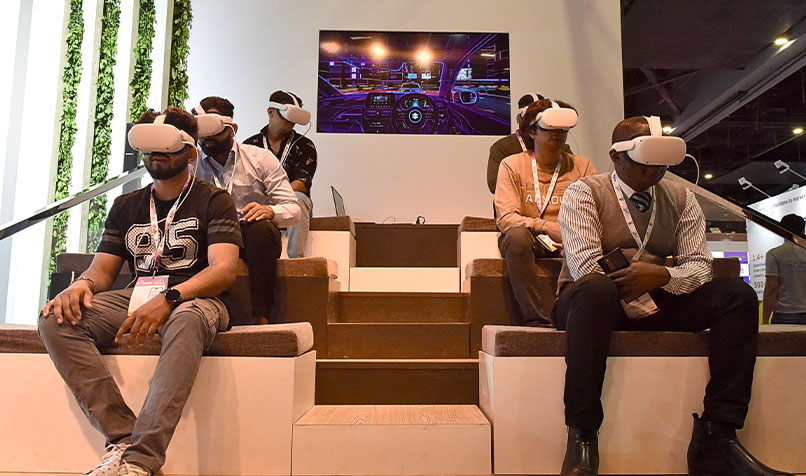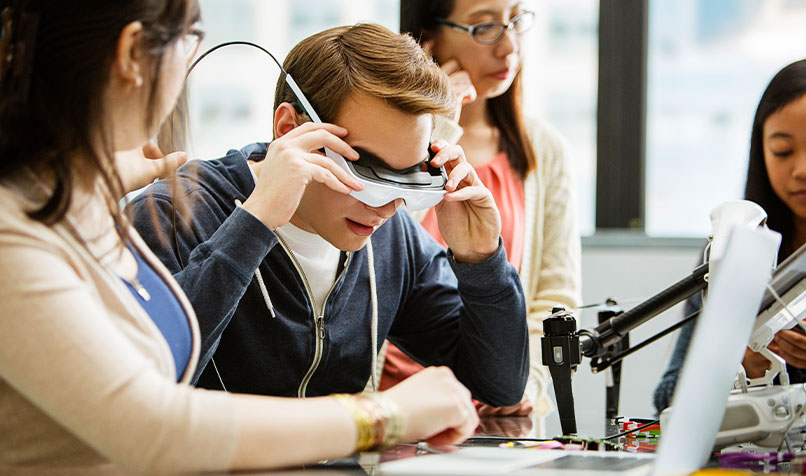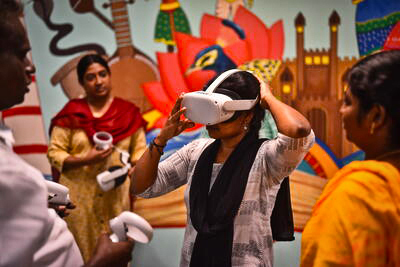Loading component...
At a glance
Employees at Bank of America have become accustomed to bank robberies – virtually, at least.
Mike Wynn, senior vice-president at The Academy for Bank of America, which helps to create learning experiences for the bank’s 200,000 employees, says that workplace training programs now include virtual scenarios.
Virtual scenarios deal with responses to bank robberies and customer interactions, so that employees know how to act safely and appropriately in the heat of the moment, because planning and rehearsals are the best defence against dangerous and stressful branch encounters, Wynn says.
“In VR, we are able to put people in a situation that creates a level of anxiety,” Wynn explains.
“Is it real? No, but when someone is in front of you saying, ‘Give me your money’, you have to make certain decisions.
“Through training, we help employees to understand which decisions will keep them, and those around them, safe. If you try to do that through traditional means, it is very tough to pull it off,” Wynn says.
As more metaverse technologies become available, Wynn believes this kind of immersive, interactive training will become especially relevant and valuable for younger generations of staff working in the bank.
“They’re the YouTube generation. They want to interact,” he says.
While training programs in the past may have left some staff with a sense of information overload, the training they receive now helps them to feel more engaged and better equipped to do their jobs. “The feedback has been, ‘I love this and want more of it’.
“Typically, that’s not what you hear with training, so it’s been radically different going down this avenue,” Wynn says.
Immersive potential

While the metaverse raises the prospect of new, immersive experiences for the education sector, for now, its infrastructure is largely a work in progress.
Dr Mark van Rijmenam, future tech strategist and author of Step into the Metaverse, says that although the metaverse is in its infancy, it has tremendous potential for use in education.
Van Rijmenam believes the prospect of learning through VR, AR and other immersive methods can be transformative.
“They have a lot more impact on your learning capabilities than just listening to someone lecturing,” van Rijmenam says.
"In VR, we’re able to put people in a situation that creates a level of anxiety. Is it real? No, but when someone is in front of you saying, ‘Give me your money’, you have to make certain decisions. Through training, we help employees understand which decisions will keep them, and those around them, safe. If you try to do that through traditional means, it is very tough to pull it off."
The metaverse could be an ideal platform for students to collaborate in real-time, facilitating group projects and peer review, which are critical components in accounting education.
Accounting students could practise financial statement analysis in a virtual environment designed to mimic real-world business scenarios.
With VR, history students could take a virtual walkthrough of Ancient Rome to learn its history, while surgeons could potentially practise particular surgeries repeatedly before performing them on a real patient.
“That’s the potential of the metaverse,” van Rijmenam says.
Nurturing curiosity
Eileen McGivney, instructor and researcher at Harvard University, has been at the forefront of using immersive technology to educate. For example, she has designed lessons using VR field trips to both Antarctica and the International Space Station.
What fascinates McGivney about how students learn using VR is that they “turn so many of the interactions that we already have with technology into three-dimensional environments”.
Although she had initially hoped virtual experiences could help her students to learn to identify, articulate and frame problems and their solutions the way that accountants, astronauts, engineers and scientists do, such a goal is too ambitious, says McGivney.
What students can do is use VR to cultivate curiosity and inquisitiveness about new environments and the people in them. For instance, the space project has given McGivney’s students a sense of what it might be like to experience zero gravity.
"If there is something you can learn easily without VR, then it is probably not worth putting into VR. The worst application of VR for learning is looking at a PowerPoint slide through VR."
“It wasn’t a specific piece of content knowledge or a specific skill that they learned,” McGivney says. “It was more a recognition of what it means to ‘do’ science and what it means to be a scientist, or, in this case, what it means to be an astronaut.”
Virtual learning could also offer students a glimpse into a company that may one day offer their dream job. They could get a feel for a role and how to fulfil it, while emboldened by the belief that they could succeed in that environment.
“In education, we call it self-efficacy,” McGivney says. “It’s the belief that you can be successful. It’s really powerful, and I think this is a good medium for that.”
As the metaverse develops, McGivney has no doubt that the implications for education, socialisation and entertainment will be significant. “I’m excited about that, not as an escape where we’re all going to live in a dystopian world, but around how we change the way we interact with digital environments,” she says.
Metaverse explained (plus 5 future jobs for you)
Soft skills

At Bank of America, Wynn says virtual training has been invaluable for teaching soft skills, such as enhancing staff interactions to help with difficult conversations. If a customer is having a bad day, a particular comment or body language from an employee can potentially ignite an even more explosive situation.
“Things our staff say can have consequences, and this can be addressed through virtual training – ‘You said this, and now the client is even more upset and wants to leave’, versus ‘If you do or say this, you may get a better outcome’.
“You can’t do this traditionally, except through role plays, which are difficult to scale. It’s not that we’ve abandoned traditional training, but from a scalability perspective we needed to do things differently, and that’s where VR has allowed us to do just that,” Wynn says.
Learning transformation
University education is experiencing rapid change through the metaverse and aligned technology. Polyversity, a virtual university, has launched in India. In the US, California State University and West Virginia University, among others, have announced plans for their own “metaversities” that will give professors and students the option of visiting a digital twin replica campus to participate in courses.
McGivney says that the metaverse can improve learning outcomes. Her research makes it clear that VR, for instance, can both deliver academic gains and activate people’s emotional responses.
“You are completely blocking out the physical environment, and you’re able to engineer the stories, the sights and sounds and what feels like a lived experience in a way that can heighten people’s fears or make them relax in a typically stressful environment,” she says.
McGivney also believes that, as the metaverse matures, it will shed light on when VR could be useful as an educational tool and when it would be redundant.
“If there is something you can learn easily without VR, then it is probably not worth putting into VR. The worst application of VR for learning is looking at a PowerPoint slide through VR,” McGivney says.
McGivney advises entities wanting to explore training via the metaverse to resist the temptation to digitise existing training programs. Instead, the focus should be on the development of new, real‑world training initiatives that empower employees to learn skills virtually without damaging a customer relationship.
For Wynn, Bank of America is proof that such a virtual approach can make a difference with customer engagement. The bank also uses virtual training to improve the employee onboarding experience. A cohort of about 1500 new employees recently had a “metaverse entry into the company” as part of their orientation.
The virtual environment is proving to be an engaging way to share the values and history of Bank of America with new employees, he says. The bank is also considering expanding virtual training for new-hire and in-role programs, diversity and inclusion measures, and workplace conduct.
“The sky is the limit with this,” Wynn says.
The metaverse: what does it mean for business?
Virtual campuses a smart move

Polyversity offers a glimpse into the future of education in India.
In June 2022, the Indian Government launched Polyversity, a virtual institution that has been described as the country’s “largest educational metaverse”.
Polyversity has been created with the goal of making education more accessible, immersive and meaningful. More than 100 academic partners have established virtual campuses as part of the Polyversity initiative.
As part of the move, the All India Council for Technical Education (AICTE) has built its own office in the metaverse, becoming the first accreditation agency in India to do so. One of the council’s tasks is to help manage multiple education certificates for all the academic partners and the awarding of degrees to students – about 300,000 students are expected to participate in the first year.
Anju De Alwis FCPA, managing director of Dubai-based e-learning provider Ultimate Access Education, says a key challenge with the initiative is providing authenticated degrees and certificates to students – the risk of forged certificates is real. “That’s where a technology solution has been required,” she explains.
AICTE uses US-based IT services consultancy Information Data Systems (IDS) to deploy and maintain this technology. IDS uses Web3 blockchain technology and the metaverse as the platform for the project.
De Alwis says the platform allows students and lecturers to create digital artefacts, such as business models or research data, that can be authenticated, valued and then shared among other students and teachers across multiple universities.
Digital contracts backed by a token can be used to ensure that the creator is rewarded for their innovation. The tokens can be converted into fiat money if required.
“All this happens using smart contracts, so you don’t have to put effort into the administration side of the transaction,” De Alwis says.
IDS is also building the Bharat Blockchain Network, which will create the capacity for blockchain projects of academic interest.
De Alwis believes accountants can step up to assist with the ethical management of the metaverse as such initiatives mature.
“With any of these technologies, we need to understand the ethics behind them, how we capture data and what we do with it,” she says. “The regulators and professional bodies, such as accountants, have a role to play, just as stock exchanges today are operated very safely. You need to have those rules, regulations and governance in place.”

